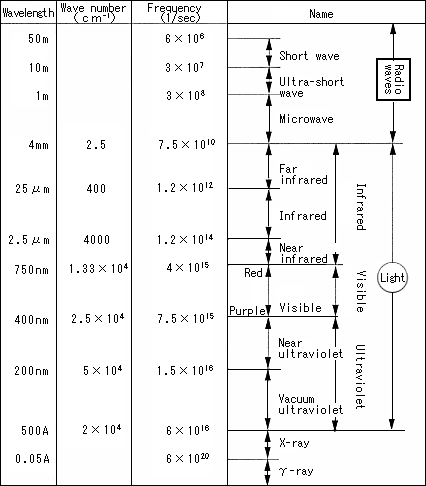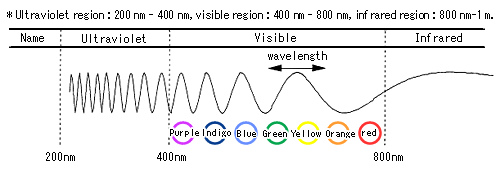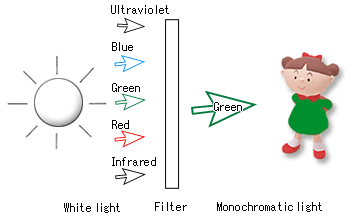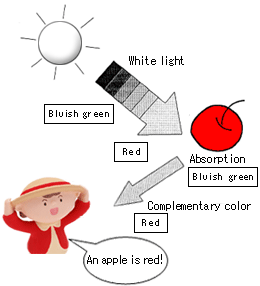2. Colorimetric Analysis (1)
Calorimetric analysis, also called "absorptiometry", is a method for analyzing a material based on its color.Now, let's see what the "color" is; that is, what the "light" is, which shows the color.
Light and color
The relationship between light, radio, and X-rays (about light)
Can you answer immediately when you are asked what light is? The "light" which surrounds us as a matter of course is a kind of electromagnetic wave, as are the radio waves of radio and television, and the X-rays used for radiography.
Light is a kind of electromagnetic wave.

Sunlight vs. the laser beam (white light and monochromatic light)
Among the forms of light shown in the table on the last page, light having wavelengths from 200 - 400 nm is called ultraviolet (UV), from 400 - 800 nm is called visible (VIS), and from 800 nm - near 1 mm is called infrared (IR). Most importantly, only visible light can be seen as a "color" with our eyes, as the name suggests.
The wavelength determines the color of visible light: red, blue, etc.
This is why the order of the colors in the rainbow is always the same.

Light containing all wavelengths, including ultraviolet, visible light, and infrared is called "white light" (for example, sunlight, an incandescent lamp, etc).
On the other hand, each color of light, (e.g., red, blue, etc) is called "monochromatic light". To illustrate, white light from sunlight may be split into the seven familiar rainbow colors (wavelengths) using a a tool such as a "filter" or "prism". In constrast, light from a laser beam consists of only one wavelength (i.e., a single wavelength).
White light: Light containing all wavelengths;
Monochromatic light: Light of single

Why is an apple red? (about color).
Newton considered why an apple falls from a tree.
Here, let's consider why an apple looks red.
Does an apple look red in a pitch-dark room at night? The answer is: NO. However, the same apple may look red when a light is turned on, or during bright daytime. This means that we need light (here, white light) to see "color."
Why does an apple look red instead of blue or yellow?
Materials such as apples, cars, and clothes have a preference for colors, just as we do.
When a certain material is exposed to light containing various colors (white light), it takes in and keeps only its favorite colors from this light (a phenomenon called "absorption"). It's disliked color (called a "complementary color") is then reflected, and becomes visible to our eyes as the color of the material.
In other words, an apple prefers blue and green and dislikes red. When it is exposed to white light, it will absorb blue and green, and look like red, which is the complementary color. Remember that anything we call "color" is related to "wavelength."
A material absorbs light of a specific wavelength.
What we see is thecomplementary color.
| Wavelength(nm) | Color | Complementary color |
|---|---|---|
| - 400 | Ultraviolet | |
| 400 - 435 | Purple | Yellowish green |
| 435 - 480 | Blue | Yellow |
| 480 - 490 | Verdigris patina | Sour orange |
| 490 - 500 | Bluish green | Red |
| 500 - 560 | Green | Purplish red |
| 560 - 580 | Yellowish green | Purple |
| 580 - 595 | Yellow | Blue |
| 595 - 610 | Sour orange | Verdigris patina |
| 610 - 750 | Red | Bluish green |
| 750 - | Infrared | - |

Invisible light (ultraviolet and infrared)
Do you understand what visible light is, from the explanation so far? If you don't, please review it. So, what are the forms of light other than visible light, such as ultraviolet and infrared which are not visible?
Ultraviolet
Ultraviolet light may cause skin cancer and suntans. Ultraviolet light, abbreviated UV, refers to an electromagnetic wave with a wavelength in the range from around 400 nm (upper limit) to around 100 nm (lower limit), although this is not so strict (the region from several tens of nm or less is called a soft X-ray). In the field of spectral analysis, the ultraviolet region of 200 nm or less is referred to as the far-ultraviolet, while 300 nm or more is called the near-ultraviolet.
Generally, an ultraviolet and visible spectrophotometer can measure wavelengths from 200 nm.

Infrared
We often hear the word, "infrared" used in terms and phrases in everyday life such as a far-infrared grill and a far-infrared kotatsu. Infrared light, abbreviated IR refers to an electromagnetic wave with a wavelength in the range from about 1 mm (upper limit; note that a part of this region overlaps with the sub-millimeter wave of microwaves) to about 800 nm (lower limit). Since infrared light exhibits a heating effect, it is also called a heat ray. That explains why infrared is used in a grill or kotatsu.
Although the classification for infrared light varies, it is usually called near infrared for wavelengths 2.5 µm or less, infrared for wavelengths from 2.5 - 25 µm, and far-infrared for wavelengths larger than 25 µm.
Although an infrared spectrophotometer is used for infrared measurement, some ultraviolet and visible spectrophotometers can measure light even the near-infrared region.

